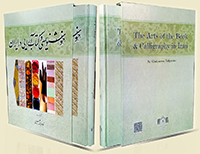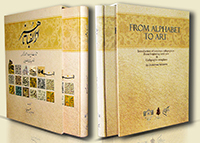
“The Arts of the Book & Calligraphy in Iran”
Author: Gholamreza Rahpeyma
Publisher : Library, Museum and Documentation center
of Islamic Consultive Assembly. Iran- Tehran (2015)
This book considers the arts of the book (calligraphy, miniature painting, illumination,
bookbinding and etc.) at the royal courts of Greater Iran and other Islamic region from
the seventh through eighteenth centuries.The text is organized in sixteen major parts:
• Chapter 1: Calligraphy Tools & Materials
The introduction of calligraphy fundamental tools includes: pen, ink, paper and etc.
• Chapter 2: Ink
The explanation of different ancient Inks, and how to make.
• Chapter 3: Pen Box (Qalamdan)
The introduction of Qalamdan history and Explaining of different kinds of Pen Box (i.e. engraved
silver, varnished papier mâché)
• Chapter 4: Paper
The presentation of paper history, Explain and discuss of variant handmade papers in Iran and papermaking.
• Chapter 5: Colored Papers
The introduction and explanation variant of national pigment used in Colored paper and dyed Techniques.
• Chapter 6: Marbled Papers
The history of Marbling, and Introduction of different Patterns and Techniques.
• Chapter 7: Coated Papers
The introduction and explain of variant Coated Paper, tools and Techniques. (* Before
a piece of paper is used for calligraphy, it is usually dyed, then coated with a starch
mixture is known as “ahar”)
• Chapter 8: Book Sizes
The introduction and explain of variant book sizes and types in civilization of Iran.
• Chapter 9: Papercutting (Qit’a)
The introduction and explain types and variation of papercutting in Persian calligraphy,
illumination and Bookbinding.
• Chapter 10: Gold leaf Uses
The introduction and explain variant Gold leaf, tools and Techniques.
• Chapter 11: Association Calligraphy and Illumination
Explaining and discussing about Association Calligraphy and illumination in Arts of
Book.
• Chapter 12: Passe-Partout (framing)
The introduction and explain variant tabulating and Passe-Partout.
• Chapter 13: Bookbinding
The introduction and explain the Persian art of Bookbinding.
• Chapter 14: Principle of Persian Calligraphy
The introduction of history of Islamic and Persian calligraphy, and explain core skills
and major factor in Persian Calligraphy.
• Chapter 15: Conservation and Restoration of Manuscripts and Documents
The introduction of deterioration Agents (i.e. Inherent vice, Pests, Environmental conditions,
Handling), Proper storage methods and restoration techniques.
• Chapter 16: Vocabulary
The presentation of major terms relating to calligraphy and Arts of Book.
|
|

“From Alfabet to Art - Introduction of common calligraphies From beginning until now &Calligraphic templates
”
Author: Gholamreza Rahpeyma
Publisher : Library, Museum and Documentation center of Islamic Consultive Assembly. with cooperative: Academy of Arts of the Islamic Republic of Iran. (2014)
Author’s Preface:
In the Name of God, who is the creator of all the beauties.
In the Name of God, who is the creator of all the beauties.
Many years ago, I was thinking on collecting the set of all the recognized
calligraphies from beginning until now and present the same to the students
of different academic disciplines, art learners and masters of calligraphy.
Such thought made me deeply study in this regard, which lasted for several
years. Therefore, I authored and wrote a comprehensive book in two volumes,
titled “From Alphabet to Art” and “The Alphabet of Art”, which are
considered as two textbooks in the field of introduction to the calligraphy
from the very beginning and calligraphy templates in the first volume, as
well as book layout techniques in the Iranian Civilization and calligraphy
manual in the second volume.
This educational and research thesis which focuses on introduction of common
calligraphies in the past and present, is the result of years of experience,
practice, research and integrated study in this field, which has been
written and published accordingly.
In the first chapter, this book introduces the calligraphic templates, e.g.
“inscription”, “black practice” and other templates and then introduces the
ancient pre-Islamic calligraphies and then studies the calligraphies and their
history and rather tries to provide the basis introduction to common calligraphies
such eras to be able to establish a sincere relationship between the
readers and such calligraphies.
Furthermore, the book introduces Kufi calligraphy as the first post-Islamic
calligraphy and then introduces and presents a variety of calligraphies in
an orderly manner, and while defining each, the history, use and masters of
such calligraphies have separately been briefed. Meanwhile, some illustrative
samples collected from across the Globe and the worldwide famous
museums are also focused.
At the end, it should be mentioned that after all what have been collected in
this thesis have been the result of considerable efforts made by me and my
colleagues in this regard. Due to some potential defects herein, I shall ask
all the beloved interested ones, artists and masters to guide me to provide a
deeper study and more acceptable work. Finally, I would like to sincerely
acknowledge all those who accompanied me in authoring this cultural piece
of work.
Gholamreza Rahpeyma
Member of International Council of Museums (ICOM)
Tehran - 2013 |
|


